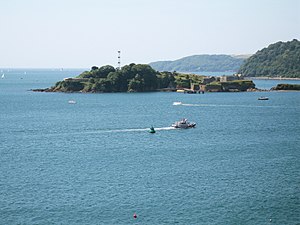Drake's Island
| Drake's Island | ||
|---|---|---|
| Drake's Iceland from Plymouth seen from | ||
| Waters | Plymouth Sound | |
| Archipelago | British Islands | |
| Geographical location | 50 ° 21 '20 " N , 4 ° 9' 13" W | |
|
|
||
| length | 400 m | |
| width | 160 m | |
| surface | 2.6 ha | |
| Highest elevation | 29 m | |
| Residents | uninhabited | |
| Drake's Island seen from the west | ||
Drake's Island is a small island off the south west coast of Great Britain . The 2.6 hectare and up to 29 meters high island is part of the urban area of Plymouth and is located in Plymouth Sound .
It was first mentioned in documents in 1135 when the island was bequeathed to the monastery at Plymouth by the Valletort family . The island had a chapel that was originally dedicated to St. Michael and later to the patron saint of seafarers, St. Nicholas , which is why the island was called St Michael's Island in the Middle Ages and later St Nicholas Island .
In 1549 the chapel had to give way to a coastal fortification . In 1583 the island passed to the English crown and the famous English navigator Sir Francis Drake became governor of the island. Since then the island has been called Drake's Island.
In 1599 barricades were built on the beach in anticipation of the Spanish Armada and the fort was expanded to accommodate 300 soldiers. When the English Civil War broke out in 1642, Sir Jacob Astley became governor of the island. Plymouth sided with the MPs. Astley's successor as governor of the island was Sir Alexander Carew , who was accused in the course of the civil war of supporting the king and providing shelter for royalists. He was arrested, imprisoned and later executed in the Tower of London .
After the Restoration of the English monarchy , the island served for 25 years as a state prison and hosted numerous prominent prisoners such as General John Lambert or Colonel Robert Lilburne , who fought on the side of Parliament and the death sentence against King Charles I had signed. They stayed on the island until their death.
The island's importance changed significantly when the Devonport naval base was opened in 1691 and the island gained a new strategic role as an upstream defense base . But in 1717 Colonel Lilley reported on the ruinous state of the defenses on the island and that it could not withstand an attack at any time.
In 1763 the island was again called St Nicolas Island and was armed with twenty-three 32-pounders, six 18-pounders as cannons and two 13-inch mortars. A semi-military group of gunners was housed on the island until 1771, but they could hardly have done anything to counter an invasion. From then until World War II, the Royal Artillery took over the cost and maintenance of the island's military defense.
Based on the recommendations of the Royal Commission on the Defense of the United Kingdom , the fortifications of Drake's Island as a key point of the new fort belt around Plymouth were greatly expanded from 1860 onwards. Five 12-inch muzzle-loaders were set up behind earthworks, and a casemate with 21 9-inch guns was built at the southern end of the island . The muzzle-loaders were replaced by more modern breech- loaders in the 1880s . In addition, a battery with wire-controlled Brennan torpedoes was built. Between 1898 and 1901 the fortifications were supplemented by two batteries, each with three QF 12 pounder 12 cwt naval guns . During the Second World War, the coastal artillery was supplemented by anti-aircraft guns . After the end of the war, the guns were dismantled in 1947 and the garrison withdrawn by 1956
In 1964, Plymouth leased the island from the Department of Defense and expanded it for youth camps. The island has been for sale since 2012 and is intended to be used for residential development.
Web links
Individual evidence
- ^ Castles and Fortifications of England & Wales: Drake's Island Fort. Retrieved February 23, 2013 .
- ↑ Victorian Forts: Drake's Island. (PDF; 134.9 KB) Retrieved March 23, 2013 .


